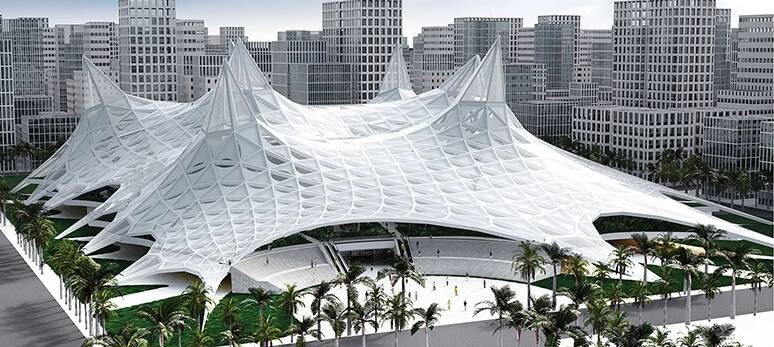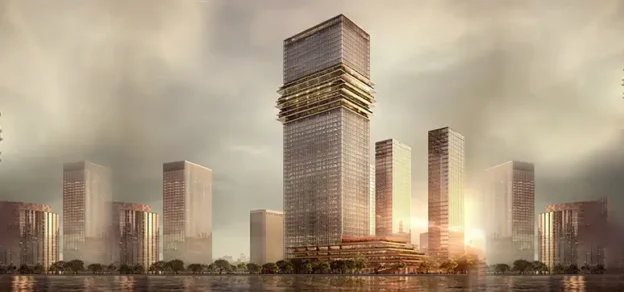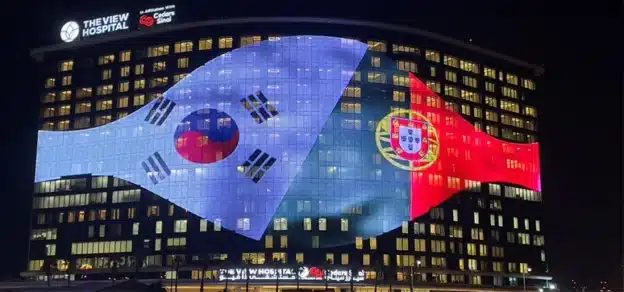Building skins and façades have a multitude of roles and functions. On one hand, they provide a visual character to a building, which extends to the local character of a neighbourhood or at times, to a skyline of a city. On the other hand, façades have a key role towards building performance and creates a link between the interiors and exteriors of a building with respect to climatic response, protection from harsh physical conditions and maintaining user comfort levels. The role of facade systems is as complex as the building itself as it needs to strike a balance between all the parameters such as aesthetics, visual character, structural stability, solar heat gain, daylight filtration, visibility, thermal comfort, branding and programmatic zoning, among other aspects.
Due to its complex nature, usually designers opt to harness the potentials of a façade to either aesthetic effects or to building performance. While there is innovation happening in various aspects of facade such as construction methods, structural facade systems deployed, new material and cladding solution and even design & aesthetics, there is still something missing out to be called as a ‘Eureka moment’ or innovation that can surpass the rigid boundaries of the conventional. Rarely one is looking into material innovation that can lead to design innovation.
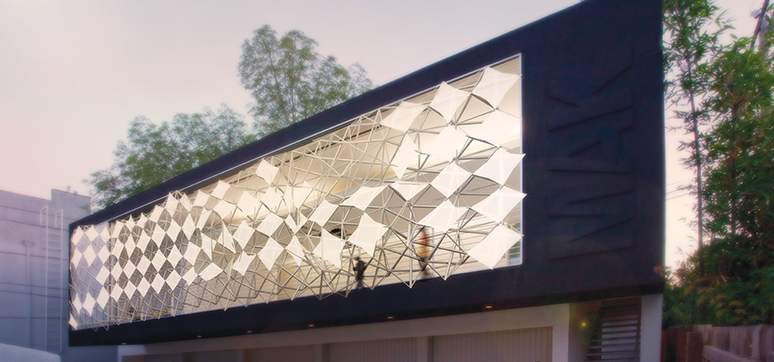
This is one area of research where rat[LAB] Studio co-founders Sushant Verma & Pradeep Devadass based their research in 2012 with a vision to develop a new facade system that can change shape using the heat from the sun and adapt to local conditions to control building performance. As complex as it may sound, and it indeed was, this is a project that had its basis rooted in years of research in the domain of adaptive and dynamic architecture, and a vision grounded somewhere in the future where material innovation would support the science behind the project.
Building Skin: Setting Up The Context Of Innovation

Buildings that inherit intelligence to move passively with the sun, to automatically control the level of heat gain and day lighting in the interior environment, is the vision of London originated research group rat[LAB], that led to the project adaptive[systems]. rat[LAB] – Research in Architecture & Technology, now headquartered in New Delhi since 2015, started the project adaptive[systems] with a sole vision of challenging the static built environment against the dynamic natural environment, where numerous layers of architecture have to come together to make a building function in negotiation with changing environmental parameters such as sun, rain and wind. The research has taken a series of iterations from 2012 to 2016, with developments shaping up in Los Angeles, CA at The MAK Center.

The team designed dynamic facade systems as a proposal for MAK’s Exhibition Space at the site of Mackey Apartments, which was designed by one of the pioneers of Modernism – Rudolph Schindler in 1939. The project questions the static nature of architectural spaces and engenders dynamism and motion in architecture in a complex and dynamic environment, combining art, architecture & interactive media. The aim is to develop prototypical systems, digitally and physically, and test them as interactive installations, speculated as building envelopes in the context of California and other geographical locations with hot climates. The installation is a system made of evolved tensegrity components, with embedded sensors and actuators, to make it respond to human movement and interacting with users through its state of dynamism and motion. Adaptive [skins] also investigates responsive building skin / facade systems that adapt to the dynamic environmental conditions.

These systems regulate the internal conditions in a habitable space over different periods of time by exhibiting a state of motion and dynamism. Heat and light are the primary parameters for regulation, leading to energy efficiency and dynamic spatial effects. Passive and active skins using shape memory alloys and pneumatic actuators are developed through investigations of smart systems that integrate smart materials and smart geometries. The precedents in this domain have rarely dealt with individually controlled multiple parameters of heat and light in a single system, which is attempted in this project.
Owing to the complexity of the multi-parametric system, genetic algorithms are developed for system optimisation and calibrated with physical prototypes at varied scales. The developed systems are tested against two distinct climatic models – New Delhi and Barcelona – and evaluated for performance, based on heat and light, which are quantified as solar gain and illuminance as principles, and daylight factor for evaluation purposes. The use of genetic algorithms makes problem-solving faster and more accurate. New tool sets are developed in the process by combining various digital tools, to create a real-time feedback and a memory loop system.
Material Intelligence

Material Intelligence was a major part of the research from project adaptive[skins], carried out in London, followed by adaptive[systems] Installation exhibited in Los Angeles. As designers, we sometimes miss out on potentials of the materials themselves and start to use them as a secondary layer. It is in these materials and their materiality that potentials can be explored, analysed & put to a smart use. A previous iteration of the interactive system uses Nitinol, a shape memory alloy in the form of compression springs that respond to heat from the sun to actuate the system passively, regulating the heat & light that permeates through the building skin, in the process.
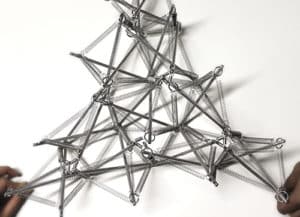
It is a prototype for investigating architecture that moves passively, without the use of any external electrical energy. It exploits the materiality and structural potentials of the system that responds to heat from the sun and gets self-actuated during the hot hours of the day to automatically move and provide controlled shading, heat gain & lighting conditions in any space. Complex algorithms are coded while designing the system to study the emergent dynamic behaviour of the system with respect to angular changes, axial shifts and force transfers, that take place when the system actuates with heat.
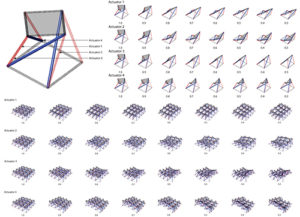
This type of a building skin can potentially be used as free standing roof structures, building façades, window panels or installations that can be pre-programmed and configured in a way that it responds to the environmental conditions of any place, while using the potentials of shape memory allow and structural principles of tensegrity, and without needing any electrical source to function. This prototypical model was exhibited in San Francisco at Maker Faire Bay Area.
Four strut tensegrity component is evolved to fit a cuboidal bounding box that can be aggregated as a 3-dimensional grid for modular assembly. Actuation experiments are carried out in a computational setting by applying forces in various springs and corresponding shape change is studied. This system responds differently with different actuations and aggregation settings, and this kinetic behaviour can be harnessed at an architectural scale to design the glow of the building skin system. An algorithm is written to control the kinetics of the system by introducing sensors that feed in the data to actuate the system. In the current prototypical iteration, we are using a proximity sensor to control movement and lighting.

An international collaboration of rat[LAB] with Takumi Yoshioka and Masaki Morinobu of Nonscale Co. Tokyo led to a proposed shopping centre in Japan & India, exhibited at the SC Fair 2016 held at Yokohama, south of Tokyo, in Japan. The project is designed by Nonscale Co., while the highlighting roof-structure has been envisaged and designed by rat[LAB]. This large span adaptive roof structure inherits hybrid qualities of a tensile and a grid shell, with automated shading devices inbuilt in the structure. The project explores Computational Techniques to develop Form, Structure & an Adaptive Skin /Envelope for the Architectural Built. The material-driven intelligence of adaptive[skins] project formed the basis for adaptive control of the building skin to derive a complex geometric system that can harness the potential of sun using sensing and actuating systems. On a large scale, Nitinol has limitations in scalability and production, but which is something that might not be constant in future and we may be able to see architectural facade systems that can make sure of shape memory allows or bimetals.
What The Future May Hold For Us

Buildings do not merely provide shade and protection from the external environment, but have a multitude of functions to perform and a range of conditions to adapt and respond to. Architecture has transformed from being functional to intelligent, with the changing requirements of time. Social environment is a constantly changing parameter and architecture needs to modulate and change with it too. Since its very origin, architecture has been evolving and developing to serve the needs of the cities and its people. In today’s complex lives however, with the fluctuating parameters and conditions of the cities and changing environments, architecture needs to serve to a multitude of functions through its life cycle. Thus it is necessary that architecture responds to all the fluctuating parameters and serves the purpose of its existence.

Project Details:
Project Title: adaptive[tensegrity]
Type: Research & Built Installation
Categories: Architecture, Material System, Computation
Location: Los Angeles, USA
Designed by Sushant Verma, Pradeep Devadass
Fabrication Collaborator: Oliver Hess (Aperiodic Industries)
Electrical Design Support: Howard Chen (Hsin-Hao Chen)
Volunteer Support: Richard Ruiz, John Whitcomb
